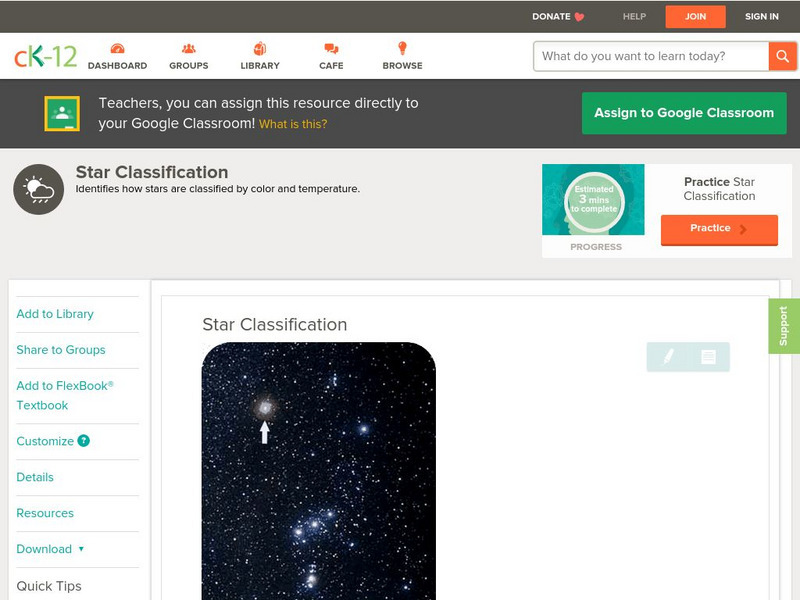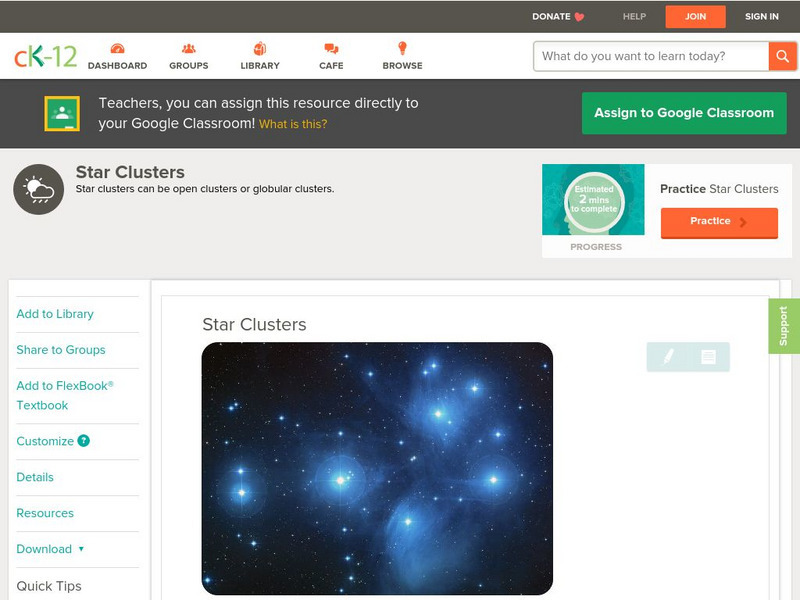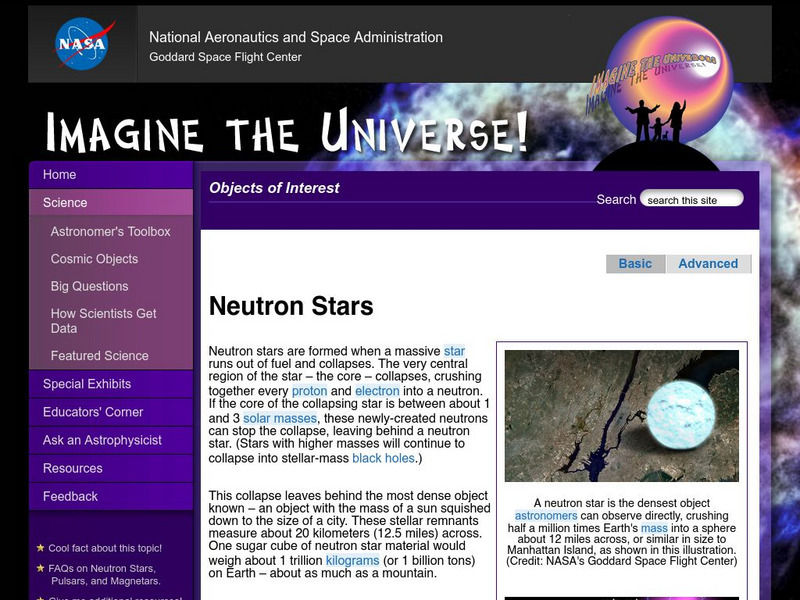California Institute of Technology
Cool Cosmos: Ask an Astronomer
What is a star? How many stars can you see at night? How far away are the stars? Find the answer to these questions and more as Cool Cosmos and NASA astronomers answer the most frequently asked questions about stars!
University of Oregon
Determining Properties of Stars
An excellent website detailing how a star's properties can be determined, and how these properties lead to the way a star is classified.
American Association of Physics Teachers
Com Padre Digital Library: Open Source Physics: Equatorial Coordinates Model
Using equatorial coordinates, observers will examine the position of a star over the course of the night sky in this simulation.
University of Utah
University of Utah: Aspire: Life Cycle of a Star
Experience this impressive interactive website about the life cycle of a star.
Globio
Glossopedia: Stars
Many of the objects you can see in the night sky are stars, large objects in space that produce light. Our galaxy, the Milky Way, contains more than 100 billion stars. Stars are so far away that their light does not reach us for years....
Cosmos 4 kids
Cosmos4 Kids: Stars
A great site to find general information on stars and their place in the universe. Click on the topics on the right margin for additional information about stars.
Cosmos 4 kids
Cosmos4 Kids: What Makes a Star?
Understand the three main characteristics of a star by reading this reference page and watching the short video.
Science Education Resource Center at Carleton College
Serc: Calculating the Declination of the Sun for Elementary Students
In the school courtyard, learners will measure the apparent path of the sun across the sky using a toilet plunger. Students will then generate questions as to why the sun appears to move, and what is really happening in the process. We...
Ministerio de Educación (Spain)
Ministerio De Educacion: Estrellas Binarias Modulo v Unidad 1
In this module you will learn the different types of binary stars.
PBS
Pbs Teachers: Shackleton's Antarctic Odyssey: Let the North Star Tell You Where
Through this lesson, students will understand how to determine latitude and locate specific stars in the night sky. They will also have a chance to build and use an astrolabe.
Other
National Optical Astronomy Observatory: Jewels of the Night
Using the Jewelbox Cluster, students determine the cluster's age based on measurements of its color and brightness.
CK-12 Foundation
Ck 12: Earth Science: Red Giants and White Dwarfs
[Free Registration/Login may be required to access all resource tools.] Describes the differences between red giant stars and white dwarf stars, and when a star becomes a red giant or a white dwarf.
CK-12 Foundation
Ck 12: Earth Science: Star Classification
[Free Registration/Login may be required to access all resource tools.] How a star is classified according to color and temperature.
CK-12 Foundation
Ck 12: Earth Science: Star Classification
[Free Registration/Login may be required to access all resource tools.] How a star is classified according to color and temperature.
CK-12 Foundation
Ck 12: Earth Science: Star Clusters
[Free Registration/Login may be required to access all resource tools.] Examines the two main types of star clusters.
CK-12 Foundation
Ck 12: Earth Science: Supergiants and Supernovas
[Free Registration/Login may be required to access all resource tools.] Explain the importance of supernovas and how a star becomes a supergiant.
Space Telescope Science Institute
Nasa: Hubble Space Telescope: Stars
At this site from the HubbleSite you can learn all about a star's life, birth, and death. Site contains links to a star movie as well as space/time location.
NASA
Nasa: Imagine the Universe: Neutron Stars and Pulsars
Discover what neutron stars and pulsars are and view pictures of them. Includes links to additional resources and lesson plans.
NASA
Nasa: Imagine the Universe: How Big Is That Star
This 2-5 day lesson plan investigates the diameter, radius and mass among several stars in order to understand stellar behavior, particularly in a binary system.
CK-12 Foundation
Ck 12: Earth Science: Life Cycles of Stars
[Free Registration/Login may be required to access all resource tools.] Examines the formation of a star and the main sequence of the star's life cycle.
American Museum of Natural History
American Museum of Natural History: Ology: What Do You Know About Stars?
Test your knowledge with this ten-question quiz on stars. Focusing on stars in the Milky Way galaxy, questions range from the life cycle of a star to the number of stars in our galaxy.
NASA
Nasa Star Child: Stars
This page details the life cycle of a star, and includes information on medium-sized and massive stars, plus a glossary and a question.
Cosmos 4 kids
Cosmos4 Kids: Take Out Your Sunglasses
This web page will discuss how a star's brightness is judged by the amount of energy it emits. Web page contains a video that explores the luminosity of a star.
Enchanted Learning
Enchanted Learning: Star Types
EnchantedLearning.com provides a thorough examination of the how stars are classified. The different types of stars are named and defined. Text is supplemented with pictures and drawings. A great introduction to the world of stars.























